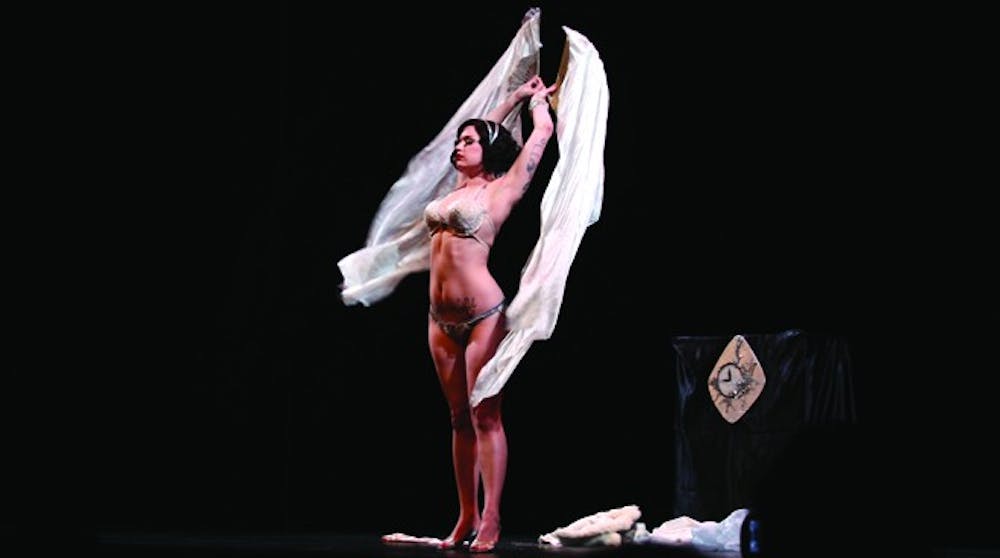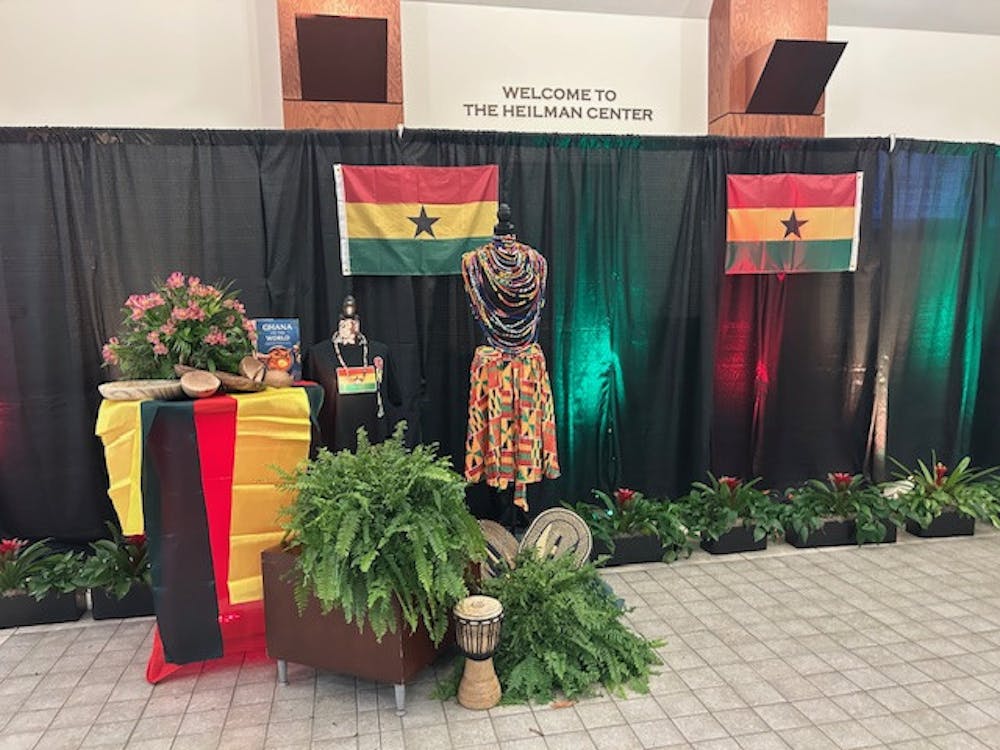The lights went dark, the crowd quieted and the theme song from "Mission Impossible" started playing as a tall figure came down the aisle, flashlight in hand at the Virginia Museum of Fine Arts' Leslie Creek Theater.
Magnolia Jackson Pickett Burnside, named "best drag performer" of 2011 by Style Weekly and hostess for the evening, hoisted herself onto the stage where a tiara sat on a pedestal. Singing "Diamonds are Forever," Burnside paused briefly to look around before placing the tiara on her head.
"Never in my wildest dreams did I ever think I would be performing at the Virginia Museum of Fine Arts," Burnside said during her opening remarks.
Dancers from the Richmond Institute of Burlesque performed at the VMFA last Friday night in a show full of glitz and glam inspired by the exhibit, "Faberge Revealed," on view through Oct. 2.
This past July, Julianne Zimmerman, coordinator of the VMFA's Friends of Art, contacted Deepa de Jour and Dolli Holiday, head instructors of the Richmond Institute of Burlesque about collaborating, after getting approval from the VMFA to host a burlesque show.
"I needed to get a lot of approval and that took a while," Zimmerman said. "A lot were skeptical about how a very adult form of entertainment would be perceived at a museum that is open to everyone."
Zimmerman said she had seen the dancers perform at the Canal Club and was impressed by their professionalism.
The Richmond Institute of Burlesque lost access to the Canal Club after Virginia Alcoholic and Beverage Control agents raided the club on July 29. Virginia law forbids stripteases on premises that serve mixed drinks.
Zimmerman stressed that they were not trying to make any political statement with the burlesque show, but were, "re-contextualizing the pieces and using artists' creativity to direct people to the show."
Holiday said: "I like the fact that we've even inspired people who came to the show to go see the exhibit, to say, 'I want to go see those.' That was the whole point. We drew people to see us, and then drew attention to the exhibit. It's a cool circle of inspiration."
The "Revealed: Faberge Burlesque" show was announced Aug. 30. The tickets sold out in nine days, Zimmerman said. The audience ranged in age from young professionals to Burnside's grandmother, Holiday said.
When de Jour and Holiday decided on the cast, they knew they were going to get a large variety of dance styles that would emphasize the differences between the Faberge pieces, de Jour said. Holiday said they had let the dancers pick the pieces they wanted.
Enjoy what you're reading?
Signup for our newsletter
There were seven acts in the show, beginning with Burnsides' performance inspired by the "Tiara," created in 1890. Holiday then performed a solo act inspired by the "Imperial Tsesarevich Easter Egg," made in 1912.
Chris Chaos, the only male dancer, did cartwheels and Russian squats in his dance inspired by the "Statuette of a Sailor." De Jour said Chaos really had done his research, and learned most of the tricks just for this performance, which was only his second choreographed performance.
De Jour then performed a dance inspired by the "Nobel Ice Egg," created in 1913. She began her dance in a long silvery dress with a fur stole, which she soon shed for a pearl- covered bikini.
Dancing next was Ophelia Derriere, who was inspired by the "Coiling Serpent Paperweight," created between 1899-1908. Derriere wore one long silver glove on her right arm, which she moved as if it was the head of a snake.
Then Philly Caramel danced on pointe, in a performance inspired by the "Imperial Rock Crystal Easter Egg," made in 1896. Caramel flew in from New Jersey, where she is a classically trained ballerina, the night of the performance, Holiday said.
Burnside said at the show, "Caramel brings more sophistication to burlesque than all the sophisticated women having tea at the Jefferson can muster up."
The Garter Snaps, Holiday and de Jour, ended the show with a performance inspired by the "Imperial Pelican Easter Egg," created in 1897. They used large white feather fans in their act to alternately cover and then reveal their bodies in a dance style de Jour said was partly inspired by the Ziegfeld Follies.
Each of the dancers chose traditional Russian music and tried to be as true to the art as possible, Holiday said, especially with the costumes. De Jour said the last few weeks all the dancers were frantically gluing on rhinestones and sewing the costumes.
There are no current plans to collaborate again, but de Jour and Holiday said they hoped that there might be future opportunities.
"We are encouraging people to write and ask for more," de Jour said. "It's your art Virginia, it's your burlesque. Tell them you want to see more of it!"
Contact staff writer Elizabeth Ygartua at elizabeth.ygartua@richmond.edu.
Support independent student media
You can make a tax-deductible donation by clicking the button below, which takes you to our secure PayPal account. The page is set up to receive contributions in whatever amount you designate. We look forward to using the money we raise to further our mission of providing honest and accurate information to students, faculty, staff, alumni and others in the general public.
Donate Now



